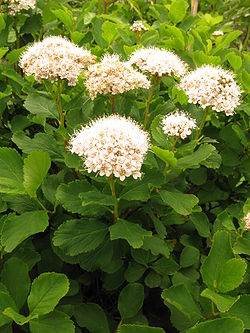mk
имиња во трошки


Birkespiræa er en lille, løvfældende busk med en tætgrenet vækst. Arten er fuldt hårdfør med smuk blomstring og flot høstfarve. Derfor bruges den (og sorter af den) meget i haver og anlæg.
Birkespiræa (Spiraea betulifolia) er en lille, løvfældende busk med en tætgrenet og kompakt vækst. Skuddene er forholdsvis tykke. Barken er først lysegrøn, men senere bliver den rødbrun. Knopperne er spredt stillede, små og let fladtrykte. Bladene er ovale og hele med bugtet rand. Begge bladsider er græsgrønne og hårløse. Høstfarven er gul. Blomstringen foregår i juni, hvor man finder blomsterne siddende i tætte, endestillede halvskærme. De enkelte blomster er regelmæssige og 5-tallige med hvide til svagt lyserøde kronblade. Frugterne er kapsler med mange frø.
Rodsystemet er tæt forgrenet og højtliggende i jorden. Planten danner udløbere og bliver med tiden mere bred end høj.
Birkespiræa når en højde på 5 m og en kronebredde ligeledes på 1 m.
Birkespiræa hører hjemme i skove, buskadser og græsområder samt langs floder og mindre vandløb i det nordøstlige Sibirien (Jakutien), i Russisk fjernøsten (Kurilerne, Khabarovsk, Primorye, Amur, Kamtjatka og Sakhalin) og i Japan (Hokkaido og Honshu). Desuden er den naturaliseret i Canada og de nordlige dele af USA[1]. I de nordlige, kystnære dele af Kamtjatka og på Sakhalin findes skove, der er domineret af Jessogran (Picea jezoensis). Her vokser arten sammen med bl.a. almindelig fjerbusk, almindelig knærod, almindelig linnæa, almindelig majblomst, Alnus kamtschatica (en art af el), Calamagrostis purpurea (en art af rørhvene), Carex pallida og Carex reventa (arter af star), dragepil, dunet egebregne, finbladet mangeløv, finsk rose, Geranium erianthum (en art af storkenæb), Juniperus sibirica (en art af ene), kamtjatkabirk, kæmpemjødurt, Lathyrus pilosus (en art af fladbælg), Lonicera chamissoi (en art af gedeblad), Pedicularis resupinata (en art af troldurt), Ribes triste (en art af ribs), skovsyre, smalbladet gederams, Solidago spiraeifolia (en art af gyldenris), Sorbus sibirica (en art af røn), svensk hønsebær, tredelt egebregne, trenervet snerre, Veratrum oxysepalum (en art af foldblad), og østsibirisk lærk.[2]
Birkespiræa er en lille, løvfældende busk med en tætgrenet vækst. Arten er fuldt hårdfør med smuk blomstring og flot høstfarve. Derfor bruges den (og sorter af den) meget i haver og anlæg.
Spiraea betulifolia, es una especie de la familia Rosaceae.[2]
Es un arbusto que alcanza un tamaño de 25-60 cm de altura desde un rizoma. Las hojas son alternas, ovadas, de 2-7 cm de longitud y de color verde. Las flores son numerosas de 3-5 cm con 5 pétalos de color blanco y a menudo, de color rosa pálido o lavanda. Los frutos son folículos de 3 mm de longitud.
Spiraea betulifolia fue descrita por Peter Simon Pallas y publicada en Flora Rossica 1: 33, pl. 16. 1784.[3][4]

マルバシモツケ(丸葉下野、学名:Spiraea betulifolia)は、バラ科シモツケ属の落葉低木。
幹の高さは50-100cmになり、よく分枝し、こんもりと丸まった樹形になる。若い枝は赤褐色になり、無毛か白軟毛がある。葉は、長さ1-3mmの葉柄をもって枝に互生し、形は倒卵形から広倒卵形または卵円形。葉の先端は円頭または鈍頭で、基部は円形または広いくさび形で葉柄に流れ、葉身の長さ1.5-6cm、幅1-4cmになる。ほとんど両面無毛で、縁には重鋸歯があり、裏面は淡緑色となる。葉の形からマルバの名がある。
花期は6-8月、枝の先に複散房状に花序をつくり、径5-8mmの白色の5弁花を多数咲かせる。花弁の長さ1.5mm。雄蕊は長く伸び、長さ7-10mmになる。
日本では、北海道、本州中北部に分布し、亜高山から高山の日当たりのよい岩礫地に生育する。世界では東シベリア、樺太、千島に分布する。